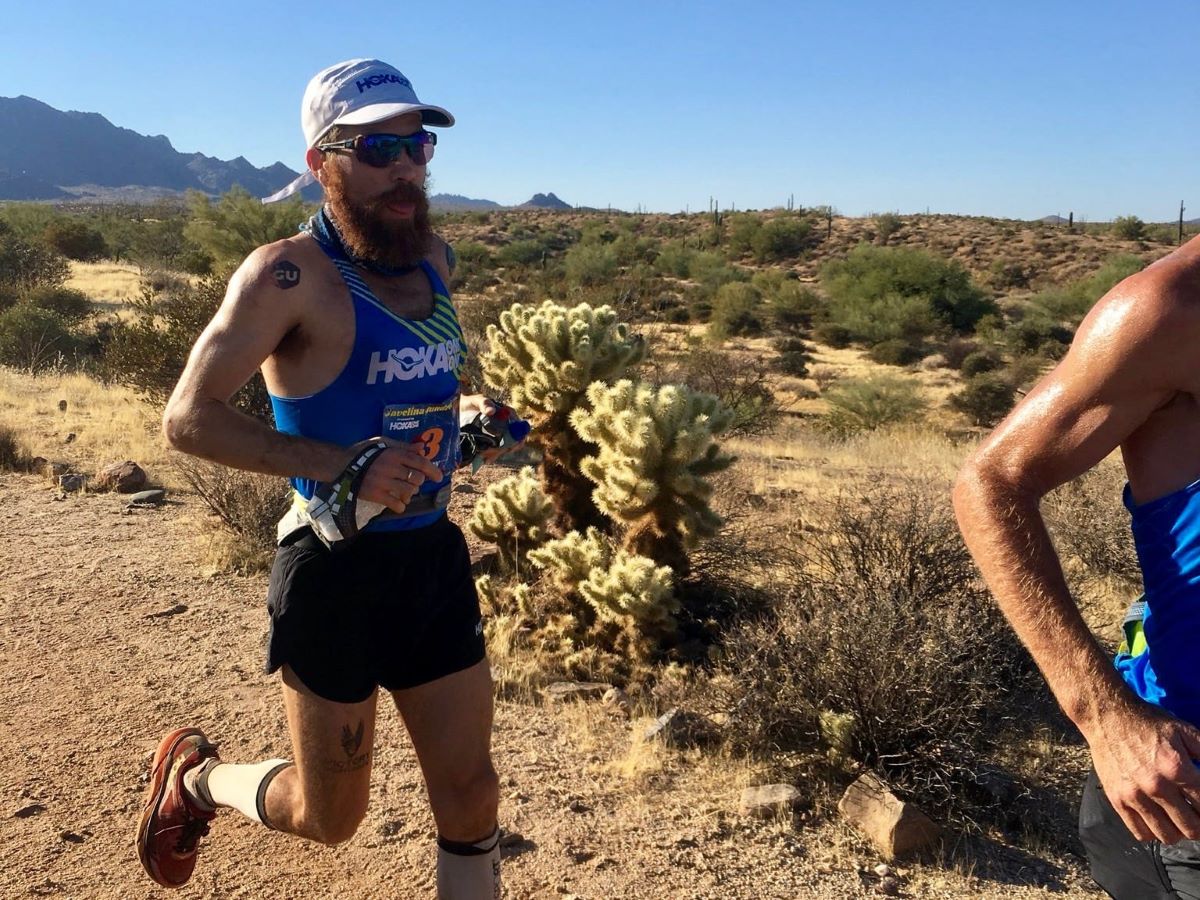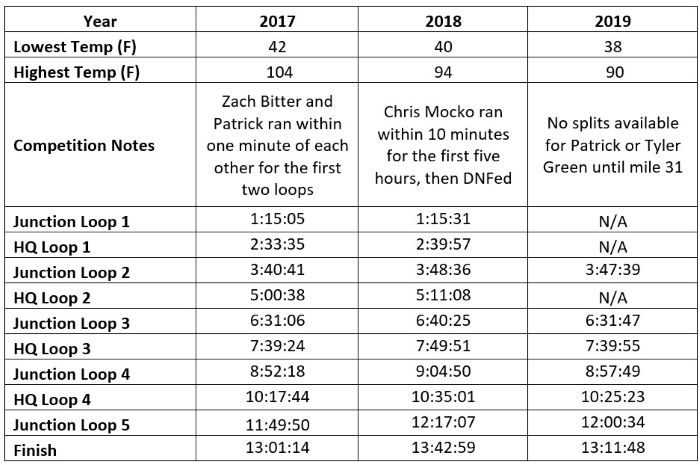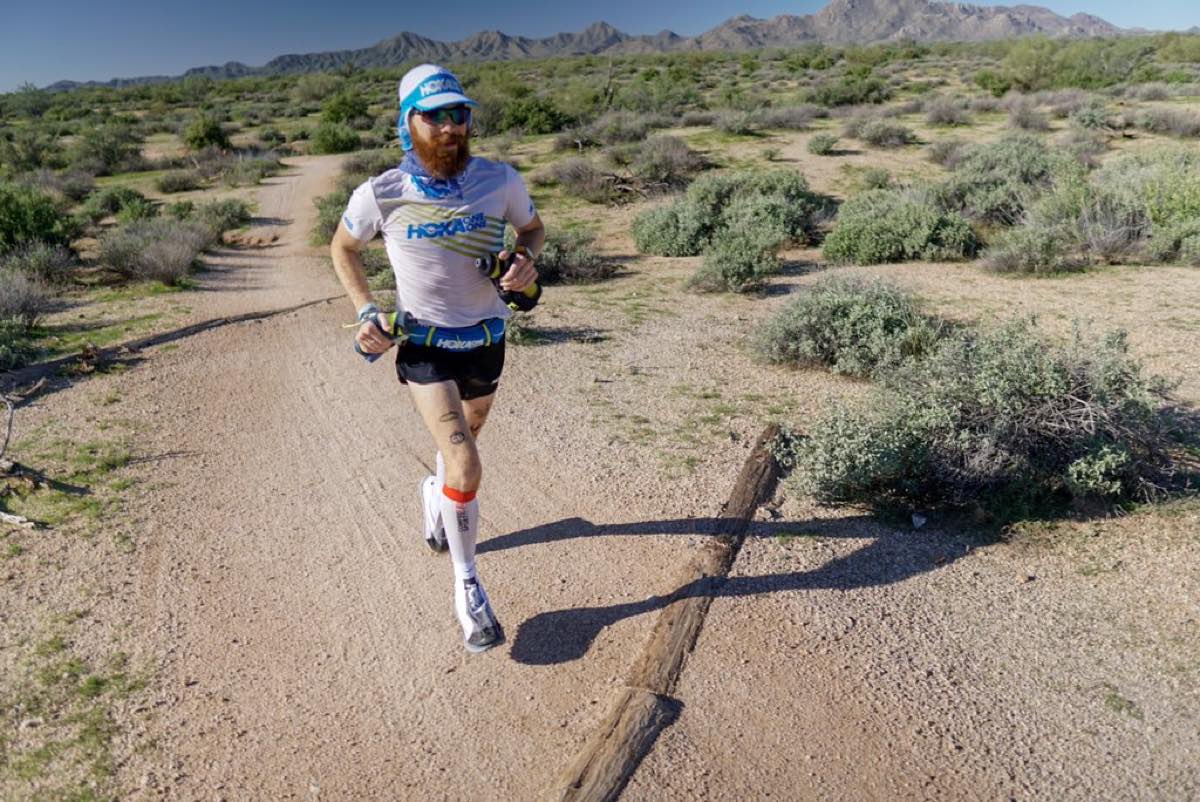If Patrick Reagan is a student of the sport of ultrarunning, you might say he’s done his dissertation on one particular race. Reagan is an accomplished runner whose top performances include, but are not limited to, two USATF 100-Mile National Championships wins, a podium finish at the IAU 100k World Championships, and a top-10 finish at the Western States 100.
There’s no shortage of races that would appeal to a fast runner who performs well at the 100-mile distance, but the Javelina Jundred Mile holds a special place in his heart — and on his arm, as he got a tattoo commemorating the race at the finish line in 2019.
Reagan is by no means the first runner to find one race so alluring he’s willing to return more than once. What’s notable about Reagan is that he set a stout course record at the event on his first try, in 2017. He has since run the race two more times, in 2018 and 2019, and will be racing again this year.
By returning to a race where he holds the course record, he faces off against some impressive competitors, as well as the ghost of his past selves. To top it all off, he keeps delivering. All three of Reagan’s Javelina Jundred Mile finishes are within 5% of each other. As of this writing, they are all among the race’s top-10 fastest finishing times.
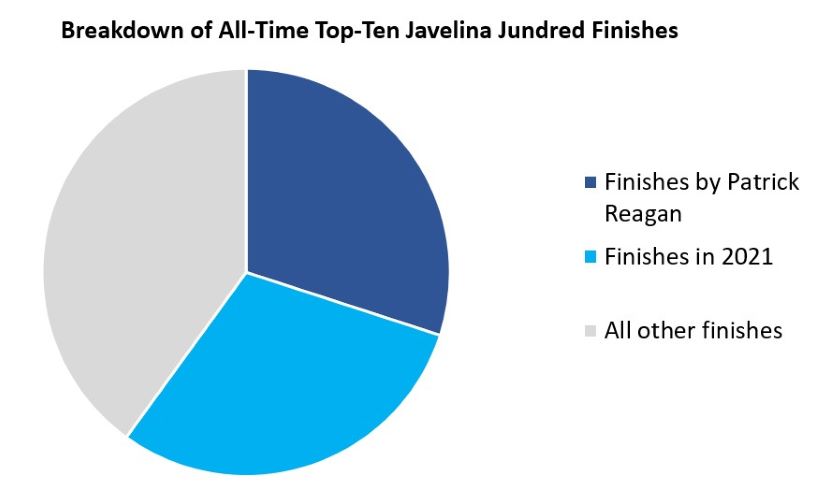
Patrick Reagan is singlehandedly responsible for three of the 10 fastest times at the Javelina Jundred Mile. On an interesting side note, another three of the 10 fastest times came in 2021, when the race awarded Golden Tickets into the Western States 100 for the first time.
I approached this article with the intention of seeing where an elite ultrarunner gains or loses precious minutes over their competition.
Data is just one part of this story. I will start by looking at Reagan’s performances, but, as you’ll see, Reagan himself suggested to me the real story is about the larger community around the event. So, in this article, I’ll present some fascinating data on what a top performance at the Javelina Jundred Mile looks like, and then share some themes from my conversation with Reagan when I asked him about the race.
The Data on Patrick Reagan at the Javelina Jundred Mile
Reagan’s consistency is quickly apparent if you look at the published splits for the Javelina Jundred Mile. There is nothing to suggest he bonked or encountered major issues on any particular leg of the race. His fastest finish was in 2017, a year he described as particularly competitive with a fast start.
I compared Reagan’s opening paces to those of other top performers at the race. While Reagan described the 2017 race as starting fast, he remained relatively steady. It’s been noted before (often in reference to a 2004 article about pacing strategies at the 2004 IAU 100k World Championships) that virtually all ultrarunners slow down during a race, but the top athletes slow relatively less. That holds true for Reagan.
As you’ll see in the chart below, his pacing strategy compares favorably to the other fastest finishers of the Javelina Jundred Mile. They are, in descending rank: Arlen Glick, Tim Tollefson, Zach Bitter, Ryan Montgomery, Hal Koerner, Paul Giblin, and Cole Watson.
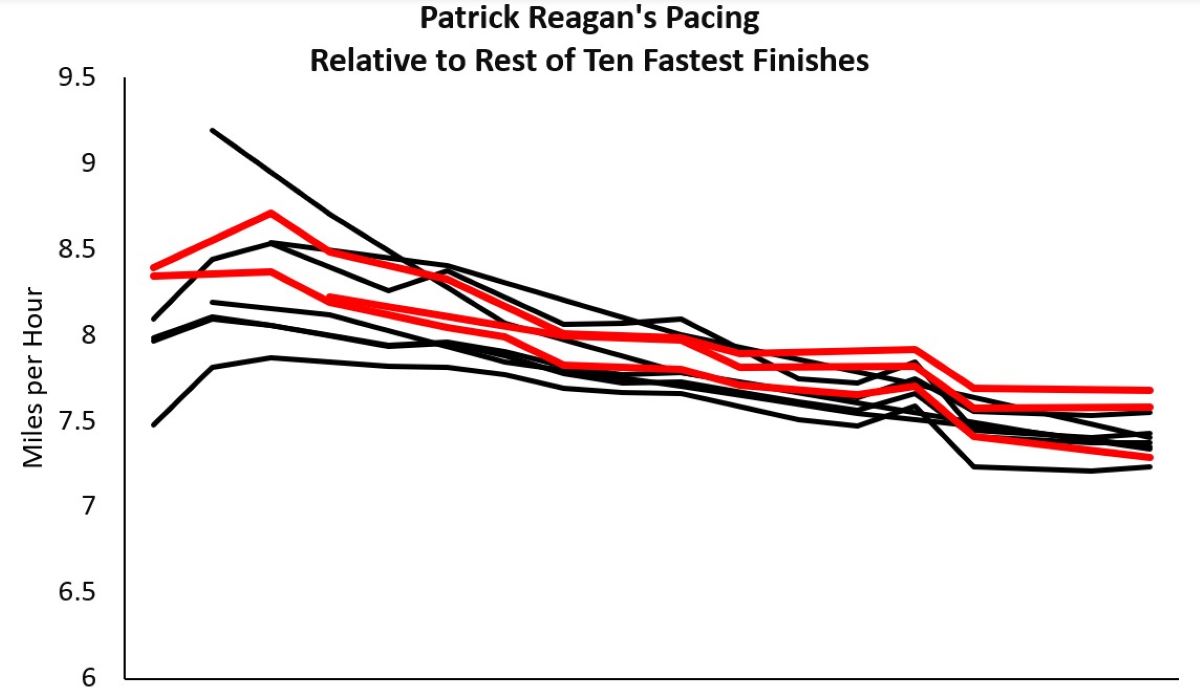
Patrick Reagan’s race performances, in red, are represented here as pacing trajectories along with those of the other fastest Javelina Jundred Mile finishes, who include in descending rank: Arlen Glick, Tim Tollefson, Zach Bitter, Ryan Montgomery, Hal Koerner, Paul Giblin, and Cole Watson. Reagan and the other competitors show fairly steady pacing and did not slow down dramatically at any point in the race. I converted paces to miles per hour (allowing the top results to appear higher on the graph, even though they represent lower/faster finishing times). Please note that fewer splits are available for earlier editions of the race.
To be thorough, I then examined Reagan’s paces relative to his competitors in each of the years that he raced. I was curious to see whether Reagan started fast to build a lead and then backed off, or if he showed a pattern of running with others. I took splits for Reagan and the other top-five finishers from each year he’s done the race, and calculated each runner’s pace for a given leg as a percentage of the pace they ran for the first leg.
Basically, I asked, “How much did each runner slow down?” Once again, Reagan’s performances (shown in red in the graph below) hold up well. The only runner who maintained a faster relative pace for the middle miles of the race was Western States 100 winner Kaci Lickteig (represented in blue in the graph below).

The top-five runners (except results for Patrick Reagan and Tyler Green in 2019, for whom early splits were not available) from 2017 to 2019 are each represented as a line in the above graph. All runners slowed as the race progressed, but in 2017, for example, Reagan had only slowed by 8% compared to his starting pace when he crossed the finish line. Kaci Lickteig’s performance is represented by the blue line above.
Patrick Reagan’s Insights on Performing at the Javelina Jundred Mile
I asked Reagan about his three winning performances at the Javelina Jundred Mile, hoping for some insight on what accounted for the modest differences in his finishing times, and how he has managed to be so consistent there. As he reflected on past years at the event, it was clear that Reagan is thorough and detail-oriented.
He corrected my web data on the daytime highs for each race. He noted he gives his crew estimates for when to expect him at aid stations, and he offered a prediction for his 2022 finishing time.
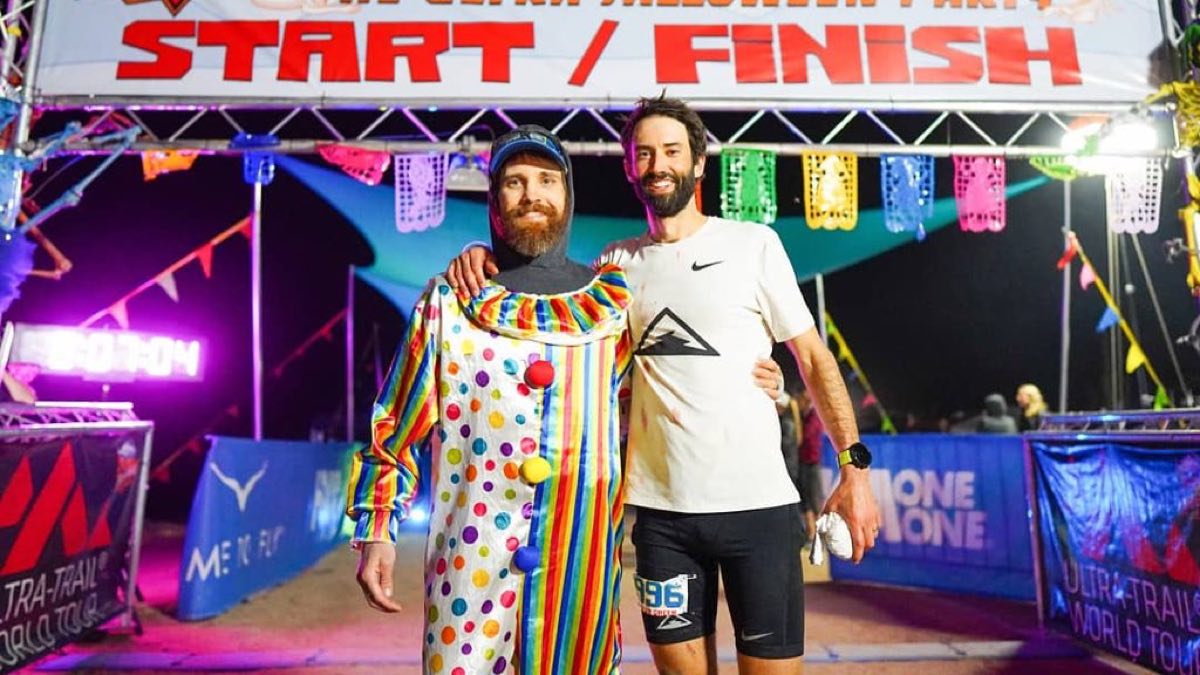
Patrick Reagan (left) clowning around at the finish of the 2019 Javelina Jundred Mile, with second-place Tyler Green. Photo: Javelina Jundred Mile
Reagan considers himself more process-driven, though. He ran each race on perceived effort and was not aware while racing in 2019 that he was so nearly matching his 2017 splits. He says he uses his watch to make sure he takes in enough calories, but otherwise gives very little thought to the numbers.
Rather than tracking splits, he espouses focusing on a “positive mental attitude,” a mantra he found in a song from the band Bad Brains. Passionate about music, Reagan found inspiration in the energy of the pioneering Black musicians who created the band in Washington, D.C., in 1976.
When I asked Reagan if testing himself against past performances motivated him to return to the event again and again, he insisted it was the sense of community. He described running with and being paced by friends from 2017 to 2019, then pacing his friend Zach Bitter in 2020.
Patrick Reagan’s Tips for Racing the Javelina Jundred Mile
True to his interest in the wider community, Reagan was keen to talk about what his fellow runners can look forward to at the Javelina Jundred Mile, and to share what he has learned. Reagan recommended desert hats and arm sleeves for desert races — preferably white ones.
He said Pam Smith’s winning strategy for the Western States 100 can be easily applied to this event. He noted that Javelina’s course is flat enough that runners need personalized pacing strategies, suggesting Andy Jones-Wilkins’ plan of alternating nine minutes of running and three minutes of hiking at the Yeti 100 Mile is very effective — it got Jones-Wilkins a sub-20 finish.
2022 Javelina Jundred Mile Contenders
There probably won’t be much hiking at the front of the field this year. The allure of a Golden Ticket into the Western States 100 has attracted stacked men’s and women’s fields for the upcoming race. When I spoke with Reagan, he was quick to share the spotlight with friends and fellow elite runners.
In that spirit, I will highlight some of the runners to watch at the 2022 Javelina Jundred Mile. For each runner, I’ve tried to select at least two results that highlight their potential at the upcoming race. They are listed in alphabetical order by last name.
2022 Javelina Jundred Mile Women
- Nicole Bitter — 1st 2020 Javelina Jundred Mile; 7th 2019 Western States 100
- Kathryn Drew (Canada) — 8th 2019 Western States 100; 1st 2019 Canyons by UTMB 100k
- Stefanie Flippin — 1st 2020 Tunnel Hill 100 Mile; 3rd 2022 Jackpot Ultras 100 Mile
- Brianna Grigsby — 2nd 2022 Flagstaff Sky Peaks 50k; 5th 2022 Black Canyon 100k
- Annie Hughes — 1st 2022 Run Rabbit Run 100 Mile; 1st 2022 High Lonesome 100 Mile
- Kaci Lickteig — 1st 2016 & 10th 2020 Western States 100; 1st 2019 & 2014 Javelina Jundred Mile
- Anne-Marie Madden (Canada) — 11th 2022 Western States 100; 3rd 2022 Black Canyon 100k
- Michelle Magagna — 1st 2022 Kettle Moraine 100 Mile; 11th 2021 Western States 100
- Manuela Soccol (Belgium) — 1st 2020 Tarawera Ultra 100k
- Devon Yanko — 1st 2022 Umstead 100 Mile; 1st 2015 Javelina Jundred Mile
- Arden Young (Canada) — 16th 2022 CCC; 1st 2021 Quad Dipsea
2022 Javelina Jundred Mile Men
- Nick Coury — 1st (and American record) 2021 Desert Solstice 24 Hour; 1st 2022 Javelina Jangover 75k
- Matt Daniels — 4th 2019 Western States 100; 5th 2022 Broken Arrow Skyrace 52k
- Arlen Glick — 3rd 2022 Western States 100; 1st 2022 Jackpot Ultras 100 Mile
- Mark Hammond — 1st 2021 Brazos Bend 100 Mile; 3rd 2018 Western States 100
- Dakota Jones — 3rd 2022 Hardrock 100; 1st 2022 Canyons by UTMB 50k
- Jacob Puzey (Canada) – 2nd 2022 Calgary Marathon 50k; 6th 2021 Javelina Jundred Mile
- Jonathan Rea — 1st 2022 Bandera 100k; 1st 2022 Quad Rock 50 Mile
- Christian Stern (Austria) — 2nd 2020 & 2022 Innsbruck Alpine Trailrun Festival 110k
Call for Comments
- Who else will you be watching in the race for a Golden Ticket at the 2022 Javelina Jundred Mile?
- Do you have a particular race or route that you return to year after year?
